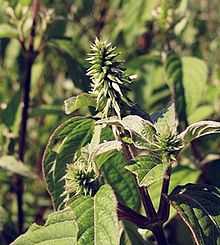Achyranthes japonica
| Achyranthes japonica | |
|---|---|
 | |
| Scientific classification | |
| Kingdom: | Plantae |
| (unranked): | Angiosperms |
| (unranked): | Eudicots |
| (unranked): | Core eudicots |
| Order: | Caryophyllales |
| Family: | Amaranthaceae |
| Subfamily: | Amaranthoideae |
| Genus: | Achyranthes |
| Species: | A. japonica |
| Binomial name | |
| Achyranthes japonica | |
Achyranthes japonica (Hangul: 쇠무릎), also known as Japanese Chaff Flower is a perennial member of the Achyranthes genus in the Amaranthaceae family. It can be discovered on the roadside and its main distribution is Korea and Japan. [1]
Ecology
Achyranthes japonica is a perennial plant growing to 50 centimetres (20 in) - 100 centimetres (39 in) tall with thickened roots. Stems are glabrous or slightly pubescent and shape quadrangular and branched. [1] Its nodes are dilated. The leaves opposite and shape elliptic or oval and slightly pubescent and have petiolate. The leaves are 10 centimetres (3.9 in) - 20 centimetres (7.9 in) long and 4 centimetres (1.6 in) - 10 centimetres (3.9 in) wide. Flowers bloom in Aug. to Sep. and inflorescence spikes in axils and at terminals of the stem. From there, tiny green flowers bloom. It has 5 stamens and a pistil in each flower and unites into one at the bottom. Tiny bracts, branch shaped, easily stick to cloth.
- Suitable pH: acid and neutral soils. [2]
It grows in woody areas in lowlands and hills. [1]
Chemical compounds
The leaves and stems and roots contain several chemical constituents.
- Seed: Insect moulting hormones like rubrosterone, ecdysterone, inokosterone
- Root: Triterpenoids, saponins.[1]
In addition, it contains protocatechuic acid, which has antioxidant properties, and also inhibits the aggregation of platelets.[1]
Traditional medicine
The root of the plant is used in the traditional medicine of Korea to treat oedema, rheumatism, delayed menses and as a contraceptive and abortifacient.
References
- ↑ 1.0 1.1 1.2 1.3 1.4 Medicinal Plants In the Republic of Korea. Natural Products research institute (Seoul National University). p. 3.
- ↑ 2.0 2.1 America, Deni Bown ; The Herb Society of (2001). New encyclopedia of herbs & their uses : [the definitive guide to the identification, cultivation, and uses of herbs ] (1st American ed. ed.). London [u. a.]: DK. ISBN 978-0789480316.